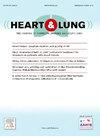Barriers and facilitators to medication adherence in patients after PCI surgery: A mixed-methods systematic review
IF 2.4
4区 医学
Q2 CARDIAC & CARDIOVASCULAR SYSTEMS
引用次数: 0
Abstract
Background
Patients after Percutaneous coronary intervention (PCI) should adhere to evidence-based medications to relieve symptoms and prevent cardiovascular events. However, the factors affecting patient medication adherence remain unclear.
Objectives
To systematically synthesize the quantitative and qualitative evidence on the barriers and facilitators to medication adherence in patients after PCI surgery.
Methods
A systematic search of the literature on the barriers and facilitators to medication adherence in patients after PCI surgery was performed in English and Chinese databases, including PubMed, Embase, CINAHL, Web of Science, CNKI, Wanfang and CBM, from inception to March 1, 2023. Retrieved studies were screened based on inclusion and exclusion criteria. Two researchers independently performed data extraction and quality assessment. The analysis of the barriers and facilitators to medication adherence in patients was based on the six sub-components of the Capability, Opportunity, and Motivation model of Behavior (COM-B) model, a behavioral science framework. The systematic review was registered on PROSPERO (CRD42022338400).
Results
A total of 15 studies were included in the review. There were 31 factors identified that influenced medication adherence in patients after PCI surgery. Among these factors, 14 served as facilitators while 17 acted as barriers. All identified factors were subsequently mapped onto the six sub-components of the COM-B model.
Conclusion
Identification of the barriers and facilitators to medication adherence within the six categories of the COM-B model in patients undergoing PCI can serve as a foundation for developing intervention strategies. These strategies should target the identified factors across the COM-B model. A comprehensive approach will improve medication adherence among PCI patients.
PCI术后患者药物依从性的障碍和促进因素:一项混合方法的系统评价
背景经皮冠状动脉介入治疗(PCI)后患者应坚持循证药物治疗以缓解症状并预防心血管事件。然而,影响患者药物依从性的因素仍不清楚。目的系统综合PCI术后患者依从性障碍和促进因素的定量和定性证据。方法系统检索PubMed、Embase、CINAHL、Web of Science、CNKI、万方、CBM等中英文数据库自成立至2023年3月1日的PCI术后患者依从性障碍及促进因素相关文献。根据纳入和排除标准对检索到的研究进行筛选。两名研究人员独立进行数据提取和质量评估。基于行为科学框架行为能力、机会和动机模型(COM-B)模型的六个子组件,对患者药物依从性的障碍和促进因素进行了分析。该系统评价已在PROSPERO注册(CRD42022338400)。结果共纳入15项研究。有31个因素影响PCI术后患者的药物依从性。在这些因素中,14个起促进作用,17个起阻碍作用。所有确定的因素随后被映射到COM-B模型的六个子组件。结论在PCI患者COM-B模型的6个类别中识别药物依从性的障碍和促进因素,可作为制定干预策略的基础。这些策略应该针对COM-B模型中确定的因素。综合方法将提高PCI患者的药物依从性。
本文章由计算机程序翻译,如有差异,请以英文原文为准。
求助全文
约1分钟内获得全文
求助全文
来源期刊

Heart & Lung
医学-呼吸系统
CiteScore
4.60
自引率
3.60%
发文量
184
审稿时长
35 days
期刊介绍:
Heart & Lung: The Journal of Cardiopulmonary and Acute Care, the official publication of The American Association of Heart Failure Nurses, presents original, peer-reviewed articles on techniques, advances, investigations, and observations related to the care of patients with acute and critical illness and patients with chronic cardiac or pulmonary disorders.
The Journal''s acute care articles focus on the care of hospitalized patients, including those in the critical and acute care settings. Because most patients who are hospitalized in acute and critical care settings have chronic conditions, we are also interested in the chronically critically ill, the care of patients with chronic cardiopulmonary disorders, their rehabilitation, and disease prevention. The Journal''s heart failure articles focus on all aspects of the care of patients with this condition. Manuscripts that are relevant to populations across the human lifespan are welcome.
 求助内容:
求助内容: 应助结果提醒方式:
应助结果提醒方式:


